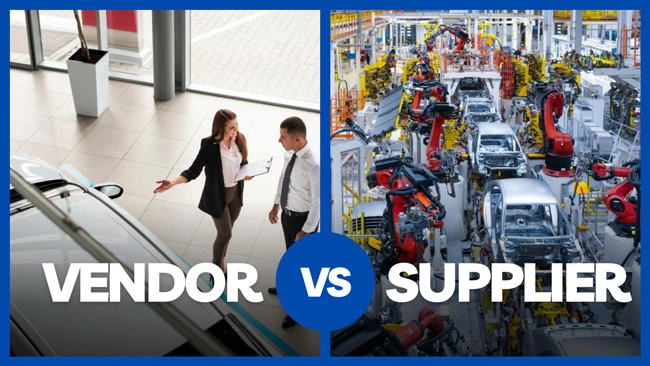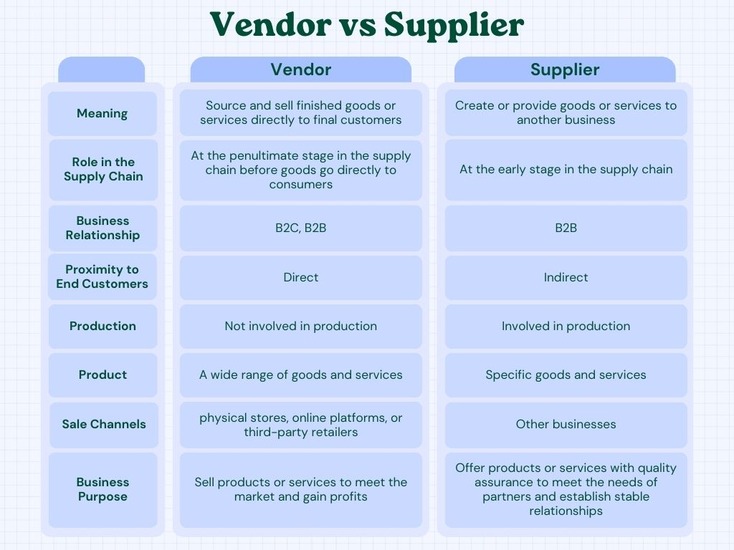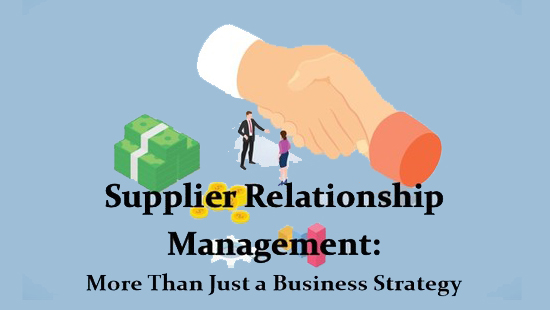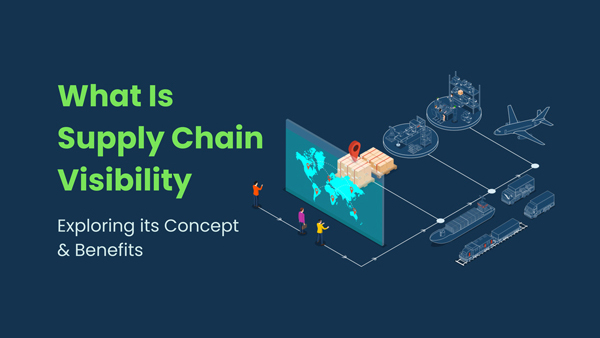Unveiling the Difference Between Vendor vs Supplier
- Date:
- Author: SVI Content Team
- Share:
If you’re new to the field of supply chain management, you may find yourself pondering questions like, “Are supplier and vendor the same thing?” or “What’s the difference between a vendor and a supplier?” A clear understanding of these distinctions is critical as you navigate through the complexity of a supply chain, which is all about the processes that take place from producing a product to selling it to the end customer.
While suppliers and vendors are both essential roles within the supply chain, the terms are often used interchangeably. To gain a solid understanding of supply chain management, a clear definition of these two terms is necessary.
This article intends to clarify the concepts and show the difference between vendor vs supplier in various aspects. Let’s delve into the details and uncover the subtle differences that set suppliers and vendors apart.
Part 1. What Do Vendor vs Supplier Mean?
In a typical supply chain, the flow of processes follows a sequence: suppliers ➡ manufacturers ➡ distributors ➡ vendors ➡ customers. It is worth noting, however, that this flow can vary depending on the specific context, and companies may assume different roles within the supply chain.
To get an idea of the distinctions between suppliers and vendors, figuring out the vendor vs supplier definition is the first thing to wade through.
Vendor vs Supplier: Definition
• What Is a Vendor?
In supply chains, a vendor, usually refers to a person or company that sells finished goods or services directly to the end customer, either an individual or a business. They can source products from suppliers or manufacturers and sell through brick-and-mortar stores or online platforms.
Vendors are customer-oriented. They have a direct relationship with customers and focus on meeting the demands of individual consumers and businesses.
• What Is a Supplier?
A supplier is a business that provides goods or services to another business or organization. They are responsible for the procurement and supply of raw materials, components, or finished goods to other businesses. Their primary focus is on producing or sourcing the goods or services they offer.
Some suppliers are involved in manufacturing activities, like providing components that are integrated into the final product, they need to process the order materials first and then ship the ready-to-sell products to other enterprises for further manufacturing.
Some suppliers serve as an intermediary between the manufacturer and the vendor to ensure the availability and quality control of the products they provide.
While comparing supplier vs vendor, the word “supplier” is more commonly used in the context of the procurement process and business-to-business relationships. On the other hand, the term “vendor” is usually used in connection with direct sales to end customers, linking the manufacturer or supplier to the end customer.
Example:
In the process of manufacturing automobiles, Company A takes pride in owning a prestigious brand. To bring their vision to life, they enlist the expertise of Company B, a service provider agent. These automobiles consist of various components, such as engines, transmissions, and electrical parts, which are sourced or produced by different companies. These component suppliers play a crucial role in providing the necessary parts to manufacturer C, who collaborates with Company B.
Manufacturer C is selected by the service provider agent to handle the production of the automobiles. They integrate the components sourced from various suppliers, ensuring that each vehicle meets the high standards set by Company A. Manufacturer C acts as a supplier to the service provider agent, providing them with the assembled vehicles once production is complete.
Upon delivery, the service provider, Company B transports the fully assembled vehicles to Company A’s destination warehouse. As the owner of the brand, Company A takes on the role of a vendor. They provide exceptional customer service and have various channels through which they can sell the final product, including brick-and-mortar stores, an official website, and authorized third-party sellers.
In this example:
- The companies that provide the components are suppliers to Manufacturer C.
- Manufacturer C is a supplier to Company B, the service provider agent.
- Company B acts as a supplier to Company A.
- Company A functions as the vendor, selling the final product to customers through their sales channels.
Part 2. What Is the Difference between Supplier and Vendor?
1. Vendor vs Supplier: Roles in the Supply Chain
Vendor and supplier both play essential roles in the supply chain link that starts with manufacturing the raw materials and ends with delivering the finished goods to the final customer. And the roles they act as is one vendor vs supplier difference.
Vendor: In the entire supply chain, vendors are close to the end of it since they can directly hand over goods to retailers or wholesalers for selling to the customers.
Supplier: Suppliers are placed at the early stage in the supply chain, supplying products or services to businesses to ensure a smooth flow of production.
2. Vendor vs Supplier: Business Relationship
Vendor: Its transactional relationship is focused on selling products or services to customers – individual or business, hence it tends to establish business-to-customer (B2C) and business-to-business (B2B) relationships.
Supplier: Providing primary goods or services, suppliers mainly deal in relationships with companies to build long-term relationships, thus facilitating business-to-business (B2B) partnerships.
3. Supplier vs Vendor: Product Focus
Vendor: Vendors usually don’t participate in the production. Vendors offer a range of products or services to cater to the needs and preferences of their target customers. They may curate a diverse product portfolio or offer a wide range of services to meet various customer demands.
Supplier: Suppliers specialize in providing specific goods or services, often focusing on a particular niche or industry. They may have expertise in manufacturing specific components or sourcing materials that are crucial for the production process.
4. Supplier vs Vendor: Sale Channels
Vendor: It sells products through various channels such as physical stores, online platforms, or third-party retailers. They often emphasize creating an appealing shopping experience, showcasing products, and providing customer support.
Supplier: In a typical scenario, the direct customers of suppliers are other companies such as manufacturers, distributors or vendors. They sell their products in bulk quantities or specialized services to them to maintain a reliable supply chain.
5. Supplier vs Vendor: Business Goals
Vendor: One difference between vendor vs supplier is their aims. By focusing on marketing and branding, vendors can attract more customers to maximize sales of goods and get profits. They are also dedicated to providing services to final customers, which can research and meet the market demands.
Supplier: The primary focus of suppliers is to meet the needs of client companies and establish relationships for further cooperation. Their reputation and relationships with other businesses in the supply chain are crucial for their success.
Part 3. Comparison Chart of Vendor vs Supplier
Part 4. Why Are Suppliers and Vendors Important in the Supply Chain?
Suppliers and vendors are indispensable components of the supply chain. Together, they contribute to the smooth and efficient flow of goods and services from production to consumption.
Suppliers offer products and services, ensuring a reliable and consistent supply for companies to meet production schedules and fulfil customer orders. By finding the right suppliers, companies can rely on their expertise and capabilities to deliver high-quality inputs. They also offer competitive pricing or discounts that can help businesses optimize their procurement processes, resulting in cost efficiencies.
Vendors bridge the gap between manufacturers and end-users. They sell their goods through multiple channels, helping to bring goods to market and making them accessible to consumers. Moreover, vendors serve as a valuable source of information as they gather feedback, gain insight into the marketplace, and learn about customer preferences. By understanding market trends and demand patterns, vendors can tailor their offerings accordingly.
Part 5. Conclusion
Understanding the difference between vendor vs supplier is relatively straightforward once you grasp their respective meanings and position in the supply chain. They are important parts of the functioning and success of the supply chain ecosystem. The key elements that differentiate a supplier and a vendor are their roles, customer relationships, product focus, sale channels and business goals. Through the knowledge of these distinctions, organizations can effectively manage their supply chains to optimize customer satisfaction and accomplish their business objectives.
Backed by more than 2 decades of experience in managing supply chains for various companies, SVI Global possesses a wealth of expertise in all aspects of the supply chain process. Our dedicated team is equipped with the knowledge and skills to handle your orders in a customized manner as per your requirements. You can rely on our services to guarantee that your products meet the highest quality standards and will be shipped to you on time.
If you are planning to venture into overseas manufacturing, partnering with SVI Global is a smart choice to reduce potential risks and achieve your goals efficiently. Our comprehensive solutions and extensive industry experience will help you navigate the challenges of a competitive international supply chain, ensuring compliance with regulations and optimizing operations.








